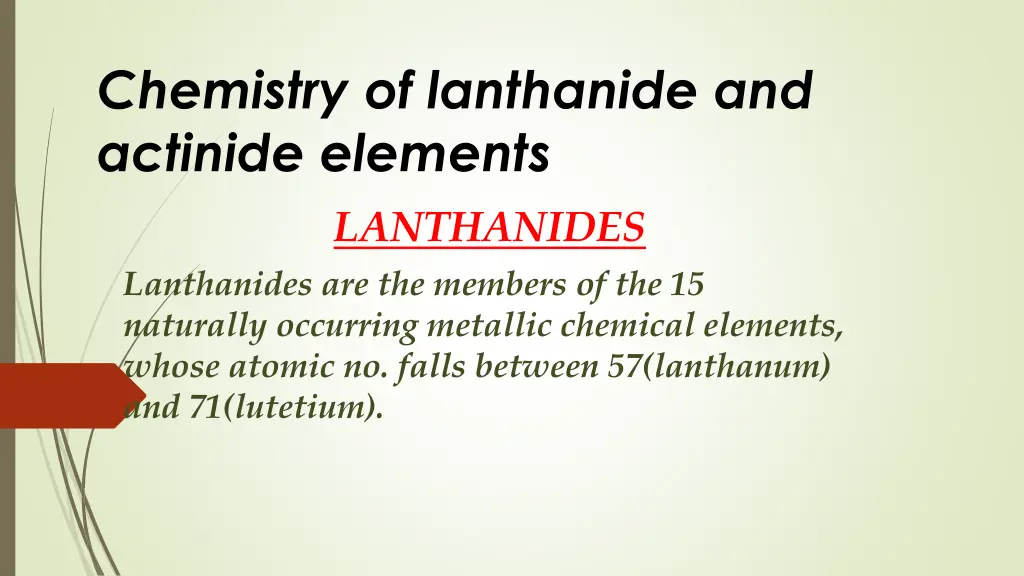
Chemistry of Lanthanide Elements: Properties, Consequences, and Compounds
Explore the physical properties, consequences of lanthanide contraction, oxidation states, isolation methods, and compounds of lanthanides. Understand their characteristics, including low ionization energies and high melting points, as well as their common oxidation states and uses in various compounds.
Download Presentation

Please find below an Image/Link to download the presentation.
The content on the website is provided AS IS for your information and personal use only. It may not be sold, licensed, or shared on other websites without obtaining consent from the author. If you encounter any issues during the download, it is possible that the publisher has removed the file from their server.
You are allowed to download the files provided on this website for personal or commercial use, subject to the condition that they are used lawfully. All files are the property of their respective owners.
The content on the website is provided AS IS for your information and personal use only. It may not be sold, licensed, or shared on other websites without obtaining consent from the author.
E N D
Presentation Transcript
Chemistry of lanthanide and actinide elements LANTHANIDES Lanthanides are the members of the 15 naturally occurring metallic chemical elements, whose atomic no. falls between 57(lanthanum) and 71(lutetium).
Physical properties of lanthanide elements 1- The lanthanides have fairly low ionization energies. 2-lanthanides have fairly high melting and boiling points. 3-The densities of lanthanides are low which ranges between 6.7 to 9.74 g cm-1. 4-the heat of fusion and heat of vaporisation also do not show definite trends with increase in atomic number . 5-The electronegativity values of lanthanide are quite close to those of alkali and alkaline earth metals . 6- Because of low ionization energy and electronegativity values ,the lanthanides are electropositive .
Ionic radii-Lanthanide Contraction Lanthanide contraction is the steady decrease in the size of atoms and ions of the rare earth elements with increase in atomic number from lanthanum through lutetium.
Consequences of lanthanide contraction. 1-Steady decrease in size . 2-Slight increase in electronegativity. 3-Incease in standard electrode potential. 4-Resemblance of second and third transition series. 5-Decreasing strength of basicity.
OXIDATION STATES OF LANTHANIDE The common oxidation states of lanthanides are +3. In addition some lanthanides show +2 and +4 oxidation states. These are shown by those elements which by doing so attain the stable f^0 , f^7 and f^14 configuration.
ISOLATION OF LANTHANINDES Methods of separation of into individual elements. 1-Repeated fractional crystallization . 2-Fractional precipitation . 3-Solvent extraction. 4- Change of oxidation states. 5-Thermal decomposition. 6- Ion exchange method. 7-By complex formation.
LANTHANIDES COMPOUNDS 1-OXIDES AND CHALCOGENIDES- 2Ln + 3O2 LnO3 2-HALIDES 2CeF3+F2 2CeF5 3-NITRIDES LaN+3H2O La(OH)3 +NH3 4-OXOSALTS OF LANTHANIDES Ln2O3+3HNO3 Ln(NO)3+NH3
USES OF LANTHANIDES 1-cerium consist about 30 to 50% of the alloys of lanthanides. Thay are used for scavenging oxygen and sulphur from other metals. 2- Addition of about 3% misch metal to magnesium increases its strength and is used in making jet engymes parts. 3- Steal mixed with La , Ce, Pr, and Nd is used in the manufacture of flame throwing tanks. 4-Lanthanides compounds are used catalysts for hydrogenation , dehydrogenation, oxidation and petroleum cracking. 5- Lanthanides oxides are used for polishing glass . Neodymium and praseodymium oxides are used for making coloured glasses for googles. 6- Cerium salts are used in dying cotton . They are also used as catalyst.
ACTINIDES The actinides or actinoid series encompasses the 15 metallic chemical elements with atomic number from 89(actinium) to 103(lawrencium).
Physical properties of actinides elements 1- the melting and boiling points of actinides are moderately high but they are considerably lower than transition elements. 2-The densities of actinides first increase and then decrease. 3-The heat of fusion and vaporization are measured only for a few elements . The heat of vaporization in general decrease from Th to Am.
Ionic radii-actinide contraction Actinide contraction is the decrease in size of atoms with the increase in atomic number in actinide series.
OXIDATION STATES OF ACTINIDES Actinides show +2,+3,+4,+5, and +6 oxidation states. However +3 oxidation state is most common among all the actinides.
COMPOUNDS OF ACTINIDES 1- OXIDES AND CALCOGENIDES- UO2CO3 heat UO3+ CO2 2- HALIDES AeX6 + 2H2O AcO2X2+ 4HX
USES OF ACTINIDES Thorium is used in the atomic reactors and in the treatment of cancers. Uranium is used as nuclear fuel machines. The salts of actinides are used in the glass industries for imparting green colour , ceramic industries, textile industries , and medicines too. Plutonium is also used as nuclear fuels and for making atomic bombs.
. THANKS THANKS






















